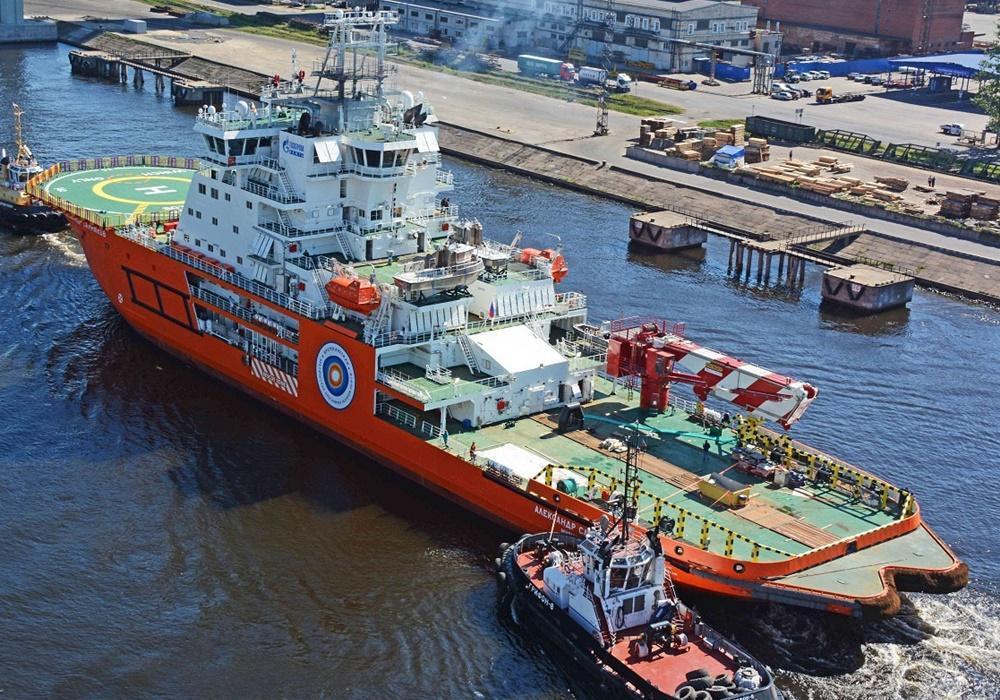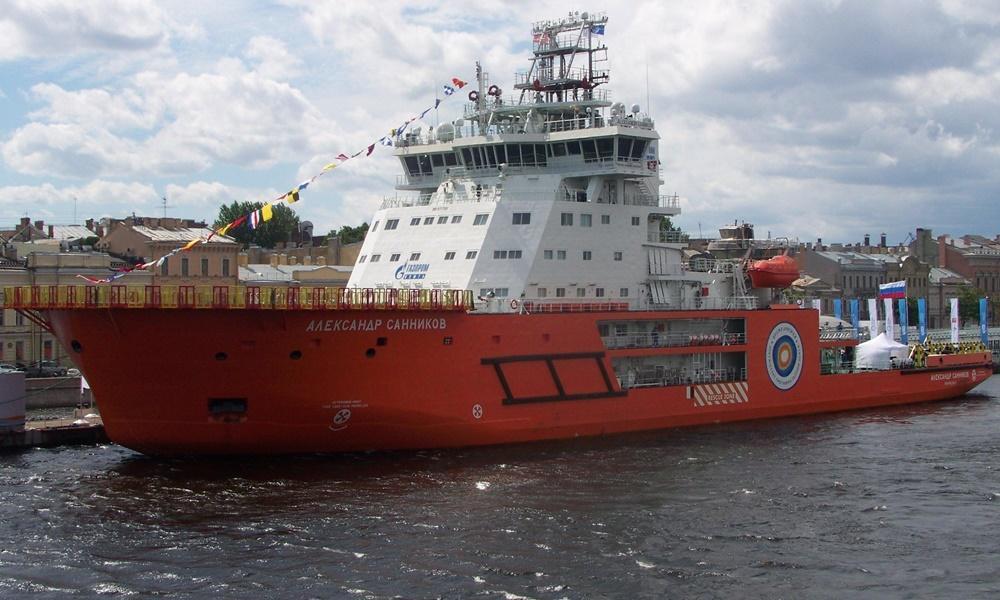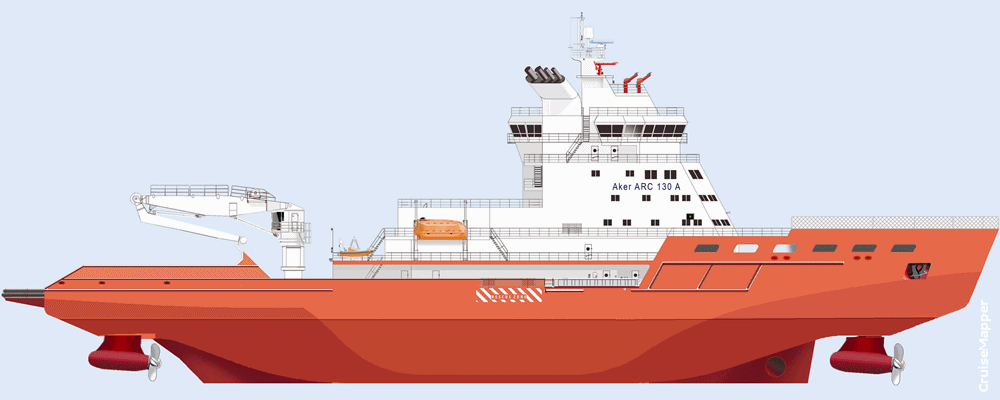Andrey Vilkitsky icebreaker
Andrey Vilkitsky icebreaker current position
The current location of Andrey Vilkitsky icebreaker is in North Russia cruising en route to RU MK:. The AIS position was last reported 55 minutes ago.
Current PositionSpecifications of Andrey Vilkitsky icebreaker
| Year of build | 2018 / Age: 7 |
| Flag state | Russia |
| Builder | Vyborg Shipyard PJSC (Vyborg, Russia) |
| Class | Aker Arctic ARC130A (Icebreaking Support Vessel) |
| Building cost | EUR 230 million (USD 270 million) |
| Engines (power) | Wartsila (27 MW / 36208 hp) |
| Propulsion power | 21.5 MW / 28832 hp |
| Speed | 16 kn / 30 km/h / 18 mph |
| Length (LOA) | 122 m / 400 ft |
| Beam (width) | 26 m / 85 ft |
| Gross Tonnage | 11295 gt |
| Beds | 35 |
| Decks | 6 |
| Decks with cabins | 2 |
| Sister-ships | Aleksandr Sannikov |
| Owner | Gazprom Neft (Russia) |
| Operator | LLC Gazprom Neft Novy Port |
Andrey Vilkitsky icebreaker Review
Review of Andrey Vilkitsky icebreaker
MS Andrey Vilkitsky ("ледокол Андрей Вилькицкий") is an icebreaking vessel owned and operated by Gazprom Neft ("Газпром нефть"). The shipowner is a Russian state-owned corporation (a subsidiary of PAO Gazprom) specializing in oil production and shipping. Gazprom Neft is headquartered in Sankt-Petersburg and is ranked as Russia's third-largest oil producer.
The vessel (IMO number 9777113) is Russia-flagged (MMSI 273412750) and registered in Sankt-Petersburg.

Both sister ships (Vilkitsky and Sannikov) are deployed in Ob Bay (Yamal Peninsula, Arctic Russia) to support Gazprom's Arctic Gate terminal (Novy Port offshore crude oil loading facility of the Novoportovskoye oil field). Their duties include escorting and assisting oil and LNG tankers operating along Russia’s Northern Sea Route, which connects Asia with Northern Europe.
These icebreakers provide mooring and tugging assistance, can conduct loading and rescue operations, and also participate in firefighting and oil spill response. Gas tankers are escorted between Port Sabetta (Yamal LNG plant) and Kamenny Cape (Ob Bay). Oil tankers are escorted to the Novy Port oil terminal (featuring sea mooring), where they receive support during mooring and loading operations.
Andrey Vilkitsky Vessel Details
In 2014, Gazprom Neft contracted Aker Arctic (Finland) to develop a conceptual vessel design based on Aker’s ARC130 supply icebreaker created for the Finnish Transport Agency (FTA). The resulting design, ARC130A ("A" for Arctic), is an enlarged version of the ARC130 model (Polaris icebreaker).
The ARC130A version features enhanced ice-strengthening, increased propulsion power (21.5 MW total output vs. 19 MW for Polaris), improved dynamic positioning, and additional systems for towing, firefighting, and oil spill response. Unlike Polaris, which operates on both LNG (Liquefied Natural Gas) and LSMDO (Low Sulfur Marine Diesel Oil), ARC130A icebreakers use only LSMDO.

The ARC130A model was verified in August 2015 following successful open-water and ice trials at Aker Arctic’s testing facility in Helsinki (Finland). The shipbuilding contract between Gazprom Neft and Vyborg Shipyard was signed in 2015 and included the construction of two vessels. The first ship (Sannikov) was delivered in June 2018, and the second (Vilkitsky) in December 2018. The vessel's projected service life is 50 years.
The ship features a double-bottom hull with structural reinforcement in critical areas, an advanced dynamic positioning-2 (DP2) and maneuvering system, state-of-the-art radio navigation equipment, remote electronic controls, an autopilot system, and an automated powerplant management system capable of operating for several days without intervention.
Compared to Russia’s nuclear-powered icebreakers, ARC130A-class ships are more cost-effective to build and maintain, offer better maneuverability, and consume less fuel. Their uniquely shaped hulls enable 360-degree turns in ice within just one minute.
In addition to icebreaking, the vessel can transport containerized cargo (up to 8 TEUs) on a dedicated cargo deck and accommodates up to 35 personnel. The aft deck is equipped with a 25-ton capacity crane (27 m reach), while the forward Helideck (14-ton capacity) can accommodate one Mi-8 helicopter (medium-sized, twin-turbine). Onboard medical facilities include an infirmary, treatment room, and quarantine cabin. Crew amenities include a mess hall, lounge, and sauna. For oil spill response, the ship is outfitted with stern-mounted brush skimmers and recovery equipment (containers and tanks) with a total capacity of 1300 m3 (46,000 ft3).
The vessel is designed for year-round operations in thick first-year ice. Classified as “Icebreaker 8” by the Russian Maritime Register of Shipping, she is capable of escorting in severe ice conditions. The ship can break 2 m (6.5 ft) thick pack ice at 2 knots (1 mps) in both forward and reverse. In brash ice, the vessel can handle up to 7 m (23 ft) at 4 knots (2 mps) in both directions.

The midship powerplant (main deck level) includes two pairs of Wartsila generator sets (medium-speed engines) with exhaust gas economizers. An auxiliary engine (harbor generator, output 1.2 MW) supplies electricity while in port. The powerplant consists of four Wartsila diesel-electric generators—two 8L32E and two 16V32E engines—with a combined output of 27 MW, along with a harbor generator (1.2 MW) and an additional emergency generator. The ship’s endurance (fuel and supplies) is 30 days.
The ABB propulsion system is diesel-electric and comprises three azipods (ABB Azipod azimuth thrusters) with fixed-pitch propellers. Two azipods are located at the stern (combined output 21.5 MW), and one at the bow (output 1.8 MW).
Note: In areas with poor AIS coverage, tracking the vessel’s current location may not be possible. For a complete list of all icebreakers and icebreaking research vessels, visit the “itinerary” section of our Icebreakers hub. All countries and their fleets are listed there.
Other Gazprom Russia cruise ships
Andrey Vilkitsky icebreaker Wiki
Vessel construction began on December 14, 2015. The ship was launched on July 5, 2017, and delivered to Gazprom Neft on December 15, 2018. Sea trials were conducted in the Gulf of Finland. The icebreaker is named after Andrey Ippolitovich Vilkitsky (1858-1913), a Belarusian hydrographer and surveyor.
The shipbuilder, Vyborg Shipyard PJSC (founded in 1948), specializes in constructing icebreakers, offshore support vessels, semi-submersible drilling and oil production platforms, and fishing trawlers. The shipyard features extensive production areas (64,000 m2 indoor and 18,500 m2 outdoor) and can build vessels with a maximum deadweight of 15,000 tons. For large ship construction, hulls are pre-assembled on the yard’s semi-submersible barge, Atlant. Since 2012, Vyborg Shipyard has been fully owned by OCK (United Shipbuilding Corporation), a state-owned Russian company that also co-owns Arctech Helsinki Shipyard (50%) with Meyer Turku Oy (50%).
Other newbuild Russian icebreaking support and supply vessels include SCF-Sovcomflot’s Vitus Bering (2012), Aleksey Chirikov (2013), Fedor Ushakov (2017), Gennadiy Nevelskoy (2017), Stepan Makarov (2017), and Yevgeny Primakov (2018). All of these icebreakers support operations at Russia’s Sakhalin 1 oil field in the Sea of Okhotsk, offshore Sakhalin Island.


